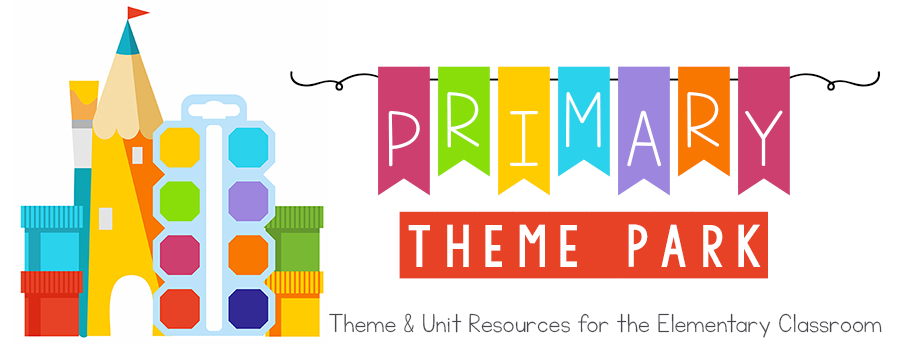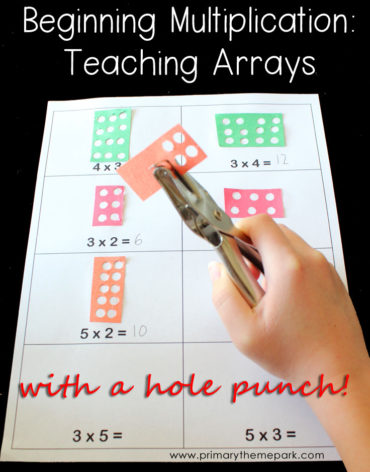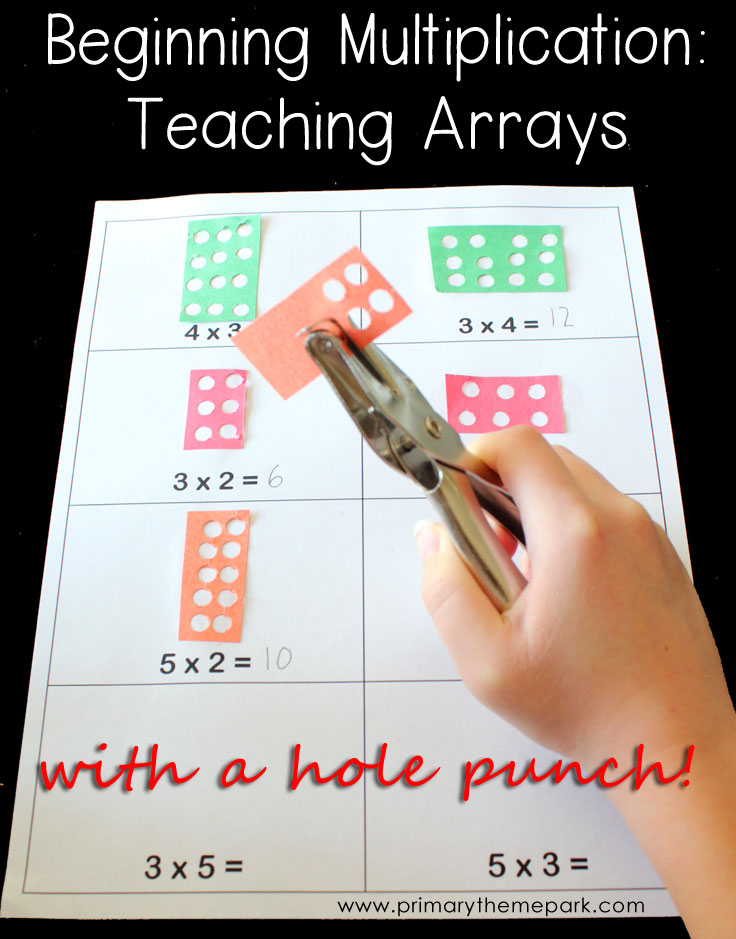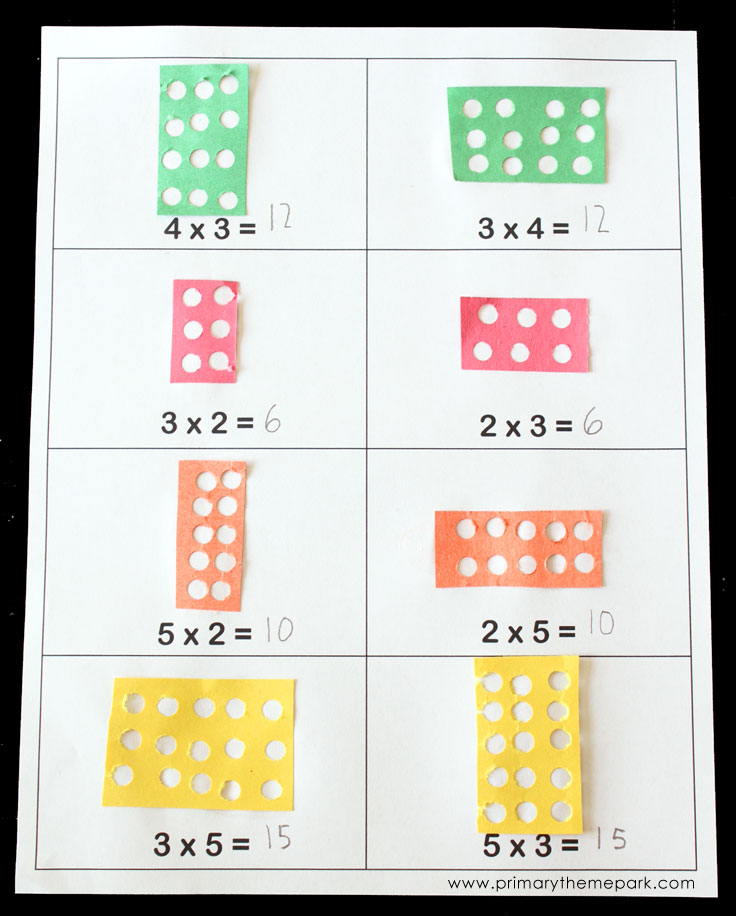This post contains affiliate links to materials I recommend. Read my full disclosure statement.
My friend, Kim, at Life Over C’s has an awesome 21 day series going on her blog called “Learn with Your Craft Stash“. The series focuses on learning activities you can do with craft items you have around your home or classroom. I’m joining in today with how to use construction paper and a hole punch to teach multiplication arrays.
What is an array, anyway? An array is an orderly arrangement (most often in rows or columns) of numbers or objects. An array can be used as a visual representation of multiplication as repeated addition.
We use Singapore Math 1A and 1B with my youngest. Beginning multiplication is introduced in first grade right after students learn repeated addition. Students go from learning and solving 2+2+2, to relating that to 2×3 (2 three times).
Here’s a fun and engaging activity we recently did when studying this concept.
Materials:
- Construction paper cut into small rectangles
- hole punch
- glue stick
- printed worksheet with multiplication facts (optional)
First, I printed out a few multiplication facts onto a sheet of paper. Another options is to just write the multiplication facts on a piece of paper or an index card.
Next, I cut several small rectangles out of construction paper.
Then, I had my son solve the multiplication problems by making an array on the rectangle with a hole punch. We talked about how the first number told him how circles to punch. The second number told him how many columns to make of that number. So in the first example, he made three columns of four circles (the number four, three times).
Once he punched all the holes, it was easy for him to look at the rectangle and count the holes to find the answer. I had him work on two problems side by side with the same factors. I wanted him to see that reversing the order of the factors didn’t change the answer. 5×2 is the same as 2×5.
To make it more challenging (and to not have small circles all over your floor!), have your students create an array for the first problem. Then, use the circles that were punched out to build another array with reversed factors. For example, I had him create an array for 5×2 using the hole punch. Next, he used the circles he punched to create an array for 2×5. It was a great visual for him to see he was using the same amount of holes/circles (10), but just rearranging them in a different way.
This activity is great for both visual and kinesthetic learners. It works great with addition problems as well. For instance, to find the answer to the addition problem 4+3, students punch four holes, punch three more holes, and then count the total number of holes they punched to find the answer.
My son loves using the hole punch and had a lot of fun using it to do his math problems!
If you’re interested into other hands-on learning activities using craft supplies you probably have lying around, click on the picture below to check out all of the “Learn with Your Craft Stash” posts!






79 Comments
This is so awesome. Glad I found it my son is a visual learner and it is really helping
I’m so happy to hear that! Another teacher friend of mine does arrays using googly eyes. She has the students glue the eyes in arrays to show different multiplication problems. It’s another fun and engaging way to practice this concept!
This is brilliant! I am an instructional designer working with teachers who work with students trying to earn their high school equivalency. Some of the students in our programs have very few numeracy skills and for the past 3 years I have repeated the phrase “why before how” until the teachers are hearing it in their sleep! I love the ideas at work here, and plan to show this to my teachers at my earliest chance! I am so happy I found you through Pinterest!! I can’t wait to see the teachers’ eyes light up when they see this!
Thank you! I love your phrase “why before how”! That perfectly sums up how I feel about teaching math. I hope this activity helps your students see and understand the why behind multiplication.
LOVED THIS!
My students love using the hole puncher – thank you! Would you mind sharing the printable?
Tres belle idée. Je vais la rajouter dans mes manipulations. Habituellement, j’utilise des centicubes , mais cette approche me semble aussi intéressante. Merci
Samya
Thank you for sharing and yes, your phrase “why before how” is ever so handy when explaining our methods not only to students but especially to parents!
Can you share the worksheet with me?
Thanks. I love this idea.
This is brilliant and a great idea for math centers. I wonder if the students could take it a step further and use the stamp cards to illustrate the distributive property (take original card, cut into 2 smaller arrays, and label each). Will definitely give this one a shot!
Hello how do I go by getting the worksheet to do this activity.
Hi Sabrina! I don’t have this particular worksheet available. I just typed a few multiplication problems I wanted my son to practice and printed them out. You can use something like Microsoft Word or PowerPoint to easily create a similar worksheet.
this is great for kids, teens or adults with dyscalculia
Love this idea of teaching arrays. Do you have a copy of the multiplication sheet with grids?
Hi! I don’t have the worksheet pictured with the problems on it unfortunately. I just typed a few problems into a table in Microsoft Word and printed it out. Maybe you can do the same!